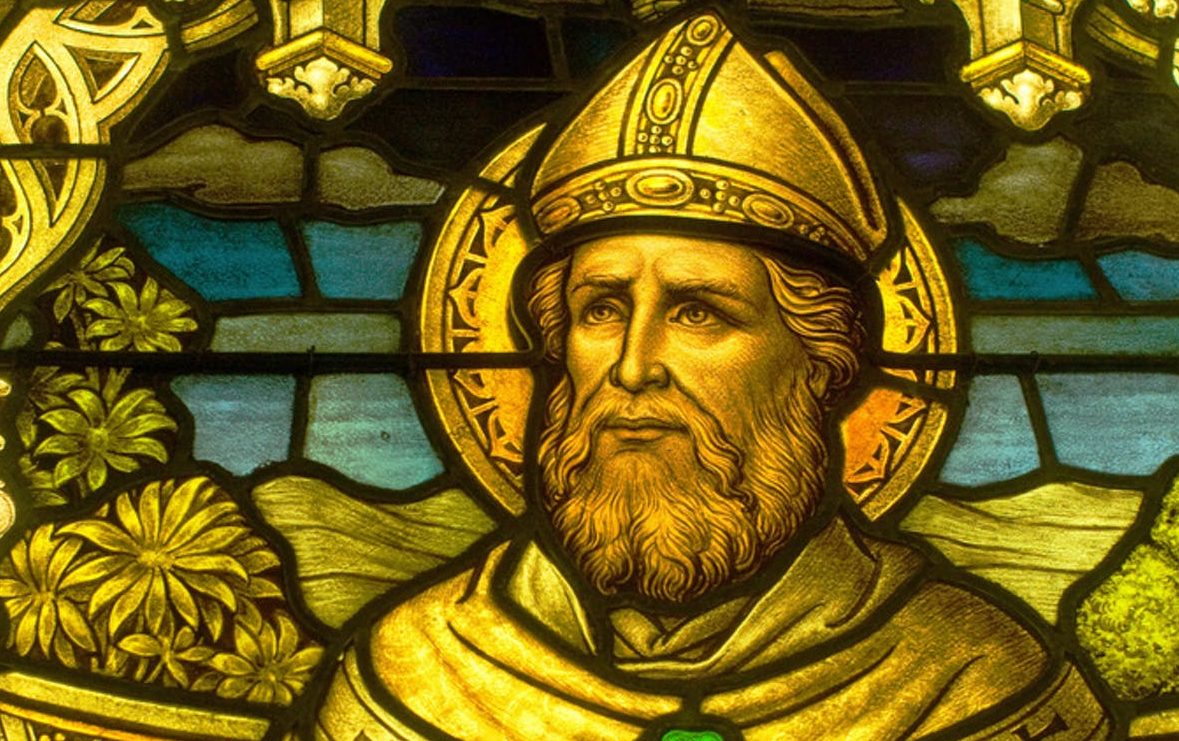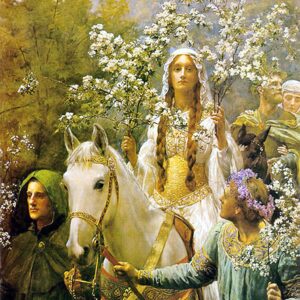Happy St. Patrick’s Day!
St. Patrick’s Day can be a strange festival in some ways. The modern rendition has grown into a secular green beer drinking, everyone’s Irish type of celebration, a day for everything imagined green and Irish. It can be a lot of fun!
Originally, March 17 was simply the Feast of St. Patrick, the date believed to have been the date of his death. My memories of St. Patrick’s day as a child are of marching in the school band, playing the tin whistle, usually with rain coming down: The local parade, the children showing their skills, a few floats, mass with hymns to St. Patrick and cúpla focail as gaelige, then home to a warm fire out of the rain. And of course, chocolate. My Granda Keohane was adamant that St. Patrick’s day like Sundays was exempt from the restrictions of Lent. So as a child, St. Patrick’s day was something to look forward to in many ways, a little fuss and praise, a little sweetness. For many people at home in Ireland today, that probably sums up the day still although a trip to the pub might also be included! Of course today (March 17, 2018) , Ireland won the grand slam in rugby so whatever about St. Patrick, it was a great day to be Irish!
Earlier this morning, reading posts on Facebook, I saw claims made that St. Patrick performed exorcisms, got rid of the old ways and destroyed the druids and belief in the Fae etc. etc. It prompted this reflection on St. Patrick and his history. The story is a little complex, as usual, so bear with me!
Who was St. Patrick?
St. Patrick was a 5th C bishop and is often credited with the conversion of Ireland to Christianity. Two documents exist which were written by Patrick himself: his Confessio and a letter he wrote to a chieftain called Coroticus, in which he decries Coroticus’ treatment of Irish Christians. Coroticus was a Briton who apparently attacked and killed some recent converts and sold others into slavery to non-Christians. In the letter, Patrick says he has excommunicated Coroticus. Presumedly then, Coroticus himself was also Christian. The letter is a plea for the return of the captives and a condemnation of Coroticus’ actions.
The second document, Confessio, is longer and contains the facts we know about Patrick. He was the son of Calpornius, a deacon whose father was Potitus, a priest, who lived at ‘Bannavem Taburniae’. We still don’t know exactly where Bannavem Taburniae was. Scotland, Wales, England and even France have places where the name Bannavem Taburniae could have been used.
Patrick recounts being captured at ‘about sixteen’ years of age, and taken to Ireland as a slave, where he deepens his religious beliefs. He escaped to Britain after 6 years, following a vision. Patrick undergoes further religious experiences, becomes a priest and eventually returns to Ireland, because of a dream. He preaches and coverts throughout the country, and baptizes, in his own words,‘many thousands of people’.
There are hints in the Confessio of accusations against him of financial impropriety and other controversies. (1) The Confessio may indeed have been written in response to whatever issues were arising in the Irish Christian community at the time.
The important thing is that this document gives us the only certain known facts we have of his life: Birth in Britain or France, captivity and slavery in Ireland, his escape and later return as a priest and bishop. It also gives us some insight into his spirituality which is Christian and his knowledge of the Bible which he refers to in numerous places in his writings.
Making use of St. Patrick: Some Agendas
The rest of the stories: expelling snakes, using the shamrock to explain the trinity, fighting with druids, etc. etc. are exactly that, stories added later through the tradition of hagiography (extolling the lives of Saints) as well as some possibly politically fueled agendas as the Church based in Rome began to extort a standardizing influence over Western Christianity. Insular Christianity (aka Celtic), which initially had connections to Eastern Christianity, differed with the developing Roman-based Church over the calculation of the dates of Easter, tonsures, penitential practices (2) and the tradition of peregrinatio pro Christo (“exile for Christ”). Other practices also differed and between the 7th and 10th century, many attempts were made to persuade the various Insular churches to accept more standardized practices.
In the midst of this, Patrick was important as he was a bishop sent from Rome and so could be used to bolster the arguments for following Roman traditions. Some of the stories about the extent of his preaching and his status as the sole converter of Ireland came about because stories about St. Patrick were conflated with the stories of Palladius, a bishop who came and preached in Ireland in the earlier 5th C. Interestingly, Palladius was sent by Pope Celestine as first bishop to the Irish believing in Christ. (Hughes, 302) In other words, there were Christians in Ireland before either bishop set foot on the land. Neither Palladius nor Patrick can therefore claim to have been the first to convert the ‘pagan’ Irish. Christianity was a growing and increasingly popular religion in the forth and fifth centuries and beyond, and there were already established Christian communities in Ireland by the early fifth century.
Many of the stories of Patrick’s life in popular consciousness come from the various lives of St. Patrick, written over the centuries. The story of his banishment of the snakes is mentioned in two 12th century documents The History and Topography of Ireland by Giraldus Cambrensis, and in Jocelin of Furness’ Life of the Saint. Muirchú’s 7th C life of St. Patrick (Vita sancti Patricii) gives us most of the miracle stories, many inspired by Biblical events, making Patrick into a type of Christian superhero. Muirchú’s own desire seems to have been for a solely Christian Ireland, a desire he reflects in his portrayal of Patrick. We can draw from this that well into the 7th C, there were non-Christian religions practiced in Ireland. Because he portrays Patrick as mainly working in the northern area of Ireland, his Vita was used to support claims to the primacy of the archbishopric of Armagh, over and above claims for Cashel, Tuam and Dublin, in the early Middle ages – something that endures until today in both the Catholic and Anglican churches.
The meeting of Pagan and Christian Ireland
There are two very interesting accounts of the meeting between Christianity and Irish pre-christian faiths that involve St. Patrick. One is Acallam na Senorach (Or “The Tales of the Elders of Ireland” which dates from the late 12th C or early 13th C. That is, it is written after the Norman occupation of Ireland and thus is speaking very much to those circumstances. The other is Agallamh Oisín agus Phádraig (Or “The Dialogue of Oisin and Patrick”), the earliest version of which dates from the 17th C (Ó Fiannachta, 189).
In Acallam na Senorach, after dispatching some demons, Patrick is portrayed as curious and interested in the stories told to him by Oisín and Caillte, two warriors of the Fianna who have survived into Patrick’s day. In fact, he is so fascinated by the stories, that he neglects his Christian duty and worries about this. However, two angels come to him and reassure him that he should not solely listen to the warriors but he should preserve their stories and traditions, as the warriors themselves now recall only about one third of these stories. Acallammakes the case for accommodating pre-Christian oral traditions of Ireland within a Christian value system.(Connell). This way of interacting with the past may have been under threat from the newer Anglo-Norman influences that came into Ireland after 1171 (3).
The fact that these stories are remembered and written about as late as 13th C implies that Christian Ireland did not overwhelm or destroy pagan Ireland but in fact, in many ways accommodated the stories and traditions. The Irish monasteries wove the pre-christian stories into Irish histories. The 11th C version of the Book of Invasions for instance, preserved the stories but gave them a Christian leaning. One example is how Cessair is made the granddaughter of Noah, and finds Ireland with her 50 women and three men after the Flood. In this way, the monasteries followed the Christian chronicle tradition whereby converted peoples added Christian elements to their traditional tales, allowing them to enter Christian history.
Agallamh Oisín agus Phádraig was written post-Reformation, 1626-7, by Aodh Ó Dochartaigh. The Patrick portrayed in this tale is confrontational and unforgiving. He will not pray for Fionn and the Fianna as Oisín requests him to do. He claims they had no room for God being interested only in the hunt and the wild. The Patrick of “Agallamh Oisín agus Phádraig” is harsh and judgmental, and has no room for the curiosity and caring of the Patrick portrayed in Acallam na Senorach, three centuries earlier. He is less flexible and far more rigid in his interpretation of Christianity. He very much reflects counter-reformation attitudes, a church on the defensive, one that neither has room for variance nor the inclusion of suspect practices.
Did Patrick wipe out pre-Christian practices?
The simple answer is no. Not even 1600 years of Christianity and almost 800 years of occupation did that. European Christianity, until the Reformation, was mainly a religion based in ritual practices. Many of the Christian ‘saints’ were christianized, local deities and their traditions were preserved as Christian traditions. Irish Christian traditions followed these practices. Even St. Brigid, one of the three patron saints of Ireland (along with Patrick and Columcille) is suspected by many to be a Christianized version of the Celtic goddess, Brigid. Additionally, Irish Brehon law seems to have survived in certain areas into the 16th C, meaning that Irish attitudes to marriage and divorce (4) and punishment (penance), were still influenced by pre-Christian traditions. The loss of life in the (19th C) famine and decrease in spoken Irish language following it probably caused more decline in tradition than all the years since the arrival of Christianity. And of course, today, those traditions are regarded by many as superstitious and better left behind.
Survival of Old Traditions
There is a fair bit of evidence that older Irish practices and traditions survived into the 20th C, and even up to today in some places. By the late 17th C, Catholicism had been outlawed in Ireland under the Penal Laws, a series of laws designed to try and force Catholics and Dissenting Protestants into following the Established (Anglican) church. Priests were exiled and Catholic practices penalized through fines and financial, social and professional impediments. Thus, there was little or no Counter-reformation Church structure or sustained influence in Ireland until the Catholic Emancipation act was passed in 1829. Older Irish traditions continued under the practices of Folk Catholicism.
Belief in the sidhe (fae/faery) survived and were documented in “The Fairy-Faith in Celtic Countries” By W. Y. Evans-Wentz in 1911. Raymond Gillespie in Devoted People, outlines Irish faith practices of the 17th century, when the divine was believed particularly accessible at certain sites, such as shrines and holy wells, and at certain times and seasons, such as Lent or on saints’ days; Signs and wonders, dreams, charms and divination and prophecy all formed part of the Irish faith traditions. Additionally, Irish wake games with their sexual and humorous components most definitely hint at non-Catholic practices surviving well into the 19th century (see Patricia Lysaght’s “Hospitality at Wakes and Funerals in Ireland from the Seventeenth to the Nineteenth Century: Some Evidence from the Written Record.” Folklore. 2003 for some intriguing details.)
A Mythic, Imaginative St. Patrick
The St. Patrick who wiped out the traditions of pre-Christian Ireland is very much a figure of imagination. Apart from the scant details Patrick himself provides in his Confessio, we really know very little about the historical figure. Yes, he was a Christian missionary and obviously converted people but there doesn’t seem to have been force involved. Indeed, he comes across in his writings as a little alone and isolated but dedicated to his path. Additionally, there were previously established Christian communities in Ireland and probably, in the way of Celtic Ireland, they lived in their own tuaths and practiced their own faith so Patrick was not bringing something new to Ireland. Irish Christians and non-Christians seem to have been living side by side for some time before his arrival.
The mythic, imaginative figure is far more detailed and interesting in many ways: but not because these accounts tell us about Patrick himself but because they tell us about the times they were written in and the desires of the people who wrote them. Whether the issue was a Christian Ireland, Roman church authority, the location of the archbishopric or the anti-tradition stance of the Counter-reformation Catholic church, St. Patrick was rolled out to support them all. These topics are not the sum total of how he has been used. I haven’t touched here on how he was viewed within the Anglican community, his relationship to Irish nationalism, modern Irish identity or the Irish diaspora, to name a few more interesting themes. Another time perhaps!
There may indeed be reasons to regret the loss of older traditions but is the issue really with Patrick or is it with something else? And which version of Patrick could be blamed, if any? The Patrick from the historical record? The one from the Vita sancti Patricii, or from “Agallamh Oisín agus Phádraig” or “Acallam na Senorach“? Or some other Patrick? Is he being rewritten today for even another agenda? After 16 centuries, there are many variations!
I’m not sure that the historical figure himself deserves the either the acclaim or the criticism heaped on him, but perhaps knowing about the various versions of St. Patrick can help us become aware of how figures like him are used to make a point or justify a history i.e. they are used for the purposes of someone else’s agenda rather than existing as their own person.
Do I have a favored version? Yes. I must say I like the Patrick of Acallam na Senorach, which should immediately alert you to some of my biases. That document suggests that there was accommodation and space in Irish Christian practice for the older traditions; that older histories were still seen as important and worth knowing about.
Maybe I feel that when angels make the case for preserving such things, we all should listen!
© Mary Diggin, Ph.D.
Notes
(1) One of these controversies seems to have been about women becoming nuns… something I hope to explore more another time.
(2) Interestingly, the Irish practice of private confession rather than public rituals was eventually adopted as a universal practice of the Church by the Fourth Lateran Council (1215). Severed from their Celtic roots, these penitential practices would develop in new ways (indulgences to name one) that could be said to have resulted sparking in the Protestant Reformation!
(3) The Norman invasion of Ireland under Henry II was purportedly in part sanctioned by Pope Adrian IV (an Englishman) so that the moral and sexual laxity of the Irish could be dealt with and that Georgian reforms enforced on the semi-autonomous Irish Christian church. The Papal Bull Laudabiliter was apparently issued by Adrian IV in 1155. No copy is extant and some doubt its authenticity. Scholars cite the many references to it as early as the 13th century to support the validity of its existence (O’Corrain, Ireland before the Normans). It was used by the English crown in justifying their occupation of Ireland. Whether it was authentic or not, the rationale it asserts of needing to bring the Irish church under Roman standards, was obviously understood as a valid concern and points to the differences at the time between Irish practices and Western Christianity’s rules.
(4)The Irish Brehon Laws, in the Cáin Lánamna, ‘The Law of Couples’, recognized up to 10 different forms of marriage, allowed for divorce for spousal abuse, impotence and desertion, among other things. ‘The Law of Couples’, described the many types of union permitted, including permanent, semi-permanent and transitory. It differed greatly from the monogamous, no divorce values of the Christian Church. The Banshenchas, the Women’s lore, also details women having married up to 6 different husbands, showing divorce was common enough.
Church law and Irish secular law diverged for many centuries. The Irish were unusual in Europe in that we preserved our own marriage laws and the freedom to marry and divorce, and even on occasion practice polygyny, into the late middle ages. Grainne Mhaol, Grace O’Malley (often known as the Pirate Queen), married her husband Risdeárd an Iarainn (“Iron Richard”) Bourke in 1566 and reputedly divorced him under the old customs after one year, by calling out “I divorce you” or “I dismiss you”. That divorce was not recognized under English law.
Resources
Connell, Sarah. Writing on the Land of Ireland: Nationality, Textuality, and Geography in the Acallam na Senórach. https://hortulus-journal.com/journal/volume-7-number-1-2011/connell/
https://www.confessio.ie/
Evans-Wentz, WY. The Fairy-Faith in Celtic Countries http://www.sacred-texts.com/neu/celt/ffcc/
Gillespie, Raymund. Devoted People. Manchester: Manchester UP, 1997
Hughes, Kathleen. “The church in Irish society, 400-800”, A New History of Ireland: Prehistoric and early Ireland, (Daibhi O Croinin, ed.) Oxford University Press, 1976,
Lysaght, Patricia. “Hospitality at Wakes and Funerals in Ireland from the Seventeenth to the Nineteenth Century: Some Evidence from the Written Record.” Folklore. 2003.
Ó Corráin, Donnchadh, Marriage in Early Ireland. https://celt.ucc.ie//marriage_ei.html
Ó Corráin, Donnchadh, Ireland Before the Normans. Dublin: Gill & Macmillan, 1972
Ó Fiannachta, Pádraig. “The Development of the Debate between Pádraig and Oisín.” Béaloideas, 54/55, 1986, pp. 183–205. JSTOR, JSTOR, www.jstor.org/stable/20522286.






